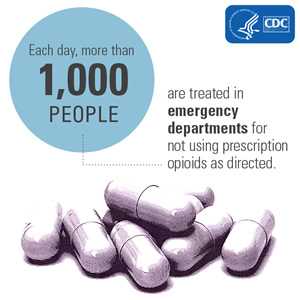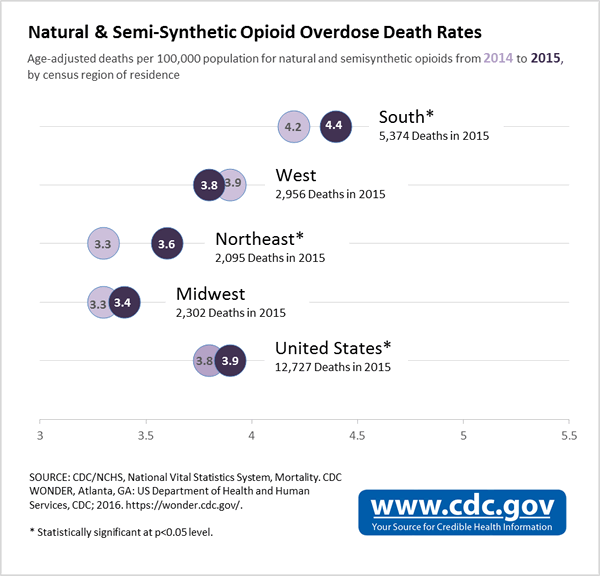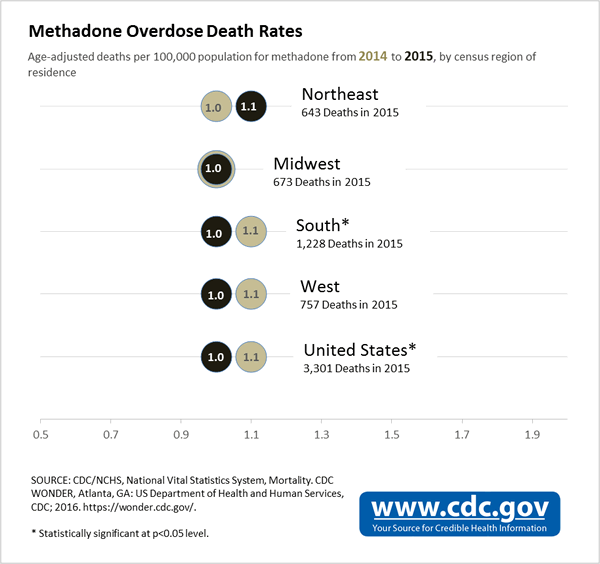Prescription Opioid Overdose Data
Overdose deaths involving prescription opioids have quadrupled since 1999,1,2 and so have sales of these prescription drugs.3 From 1999 to 2015, more than 183,000 people have died in the U.S. from overdoses related to prescription opioids.1,2
- Overdose Data
- Natural and Semi-Synthetic Map
- Natural and Semi-Synthetic Graph
- Methadone Map
- Methadone Graph
Opioid prescribing continues to fuel the epidemic. Today, nearly half of all U.S. opioid overdose deaths involve a prescription opioid.1 In 2015, more than 15,000 people died from overdoses involving prescription opioids.
Most Commonly Overdosed Opioids 
The most common drugs involved in prescription opioid overdose deaths include:
- Methadone
- Oxycodone (such as OxyContin®)
- Hydrocodone (such as Vicodin®)4
Overdose Deaths
Among those who died from prescription opioid overdose between 1999 and 2014:
- Overdose rates were highest among people aged 25 to 54 years.
- Overdose rates were higher among non-Hispanic whites and American Indian or Alaskan Natives, compared to non-Hispanic blacks and Hispanics.
- Men were more likely to die from overdose, but the mortality gap between men and women is closing.5
Additional Risks
Overdose is not the only risk related to prescription opioids. Misuse, abuse, and opioid use disorder (addiction) are also potential dangers.
- In 2014, almost 2 million Americans abused or were dependent on prescription opioids.6
- As many as 1 in 4 people who receive prescription opioids long term for noncancer pain in primary care settings struggles with addiction.7
- Every day, over 1,000 people are treated in emergency departments for misusing prescription opioids.8

Age-adjusted death rates for natural and semi-synthetic opioids are displayed above by census region for 2014 to 2015. Rates increased in the Northeast (9.1%) and South (4.8%), and in the United States overall (2.6%).2 Deaths were classified using the International Classification of Diseases, Tenth Revision (ICD–10). Drug overdose deaths were identified using underlying cause-of-death codes X40–X44, X60–X64, X85, and Y10–Y14. Drug overdose deaths were defined as having natural and semi-synthetic opioids (T40.2) as contributing causes. Age-adjusted death rates were calculated using the direct method and the 2000 standard population.2

Age-adjusted death rates for methadone are displayed above by census region for 2014 to 2015. Rates decreased in the South, and in the United States overall, a statistically significant 9.1% decrease for both.2 Deaths were classified using the International Classification of Diseases, Tenth Revision (ICD–10). Drug overdose deaths are identified using underlying cause-of-death codes X40–X44, X60–X64, X85, and Y10–Y14. Drug overdose deaths were defined as having methadone (T40.3) as a contributing cause. Age-adjusted death rates were calculated using the direct method and the 2000 standard population.2
References
- CDC. Wide-ranging online data for epidemiologic research (WONDER). Atlanta, GA: CDC, National Center for Health Statistics; 2016. Available at http://wonder.cdc.gov.
- Rudd RA, Seth P, David F, Scholl L. Increases in Drug and Opioid-Involved Overdose Deaths — United States, 2010–2015. MMWR Morb Mortal Wkly Rep. ePub: 16 December 2016. DOI: http://dx.doi.org/10.15585/mmwr.mm6550e1.
- Frenk SM, Porter KS, Paulozzi LJ. Prescription opioid analgesic use among adults: United States, 1999–2012. NCHS data brief, no 189. Hyattsville, MD: National Center for Health Statistics. 2015.
- Ossiander EM. Using textual cause-of-death data to study drug poisoning Ossiander EM Am J Epidemiol. 2014 Apr 1;179(7):884-94. doi: 10.1093/aje/kwt333. Epub 2014 Feb 1112.)
- Centers for Disease Control and Prevention, National Center for Health Statistics. Multiple Cause of Death 1999-2014 on CDC WONDER Online Database, released 2015. Data are from the Multiple Cause of Death Files, 1999-2014, as compiled from data provided by the 57 vital statistics jurisdictions through the Vital Statistics Cooperative Program. Accessed at http://wonder.cdc.gov/mcd-icd10.html.
- Substance Abuse and Mental Health Services Administration, National Survey on Drug Use and Health, 2014.
- Boscarino JA, Rukstalis M, Hoffman SN, et al. Risk factors for drug dependence among out-patients on opioid therapy in a large US health-care system. Addiction 2010;105:1776–82. http://dx.doi. org/10.1111/j.1360-0443.2010.03052.x
- Substance Abuse and Mental Health Services Administration. Highlights of the 2011 Drug Abuse Warning Network (DAWN) findings on drug-related emergency department visits. The DAWN Report. Rockville, MD: US Department of Health and Human Services, Substance Abuse and Mental Health Services Administration; 2013. Available from URL: http://www.samhsa.gov/data/2k13/DAWN127/sr127-DAWN-highlights.htm
- Page last reviewed: August 1, 2017
- Page last updated: August 1, 2017
- Content source:
- Centers for Disease Control and Prevention,
- National Center for Injury Prevention and Control,
- Division of Unintentional Injury Prevention


 ShareCompartir
ShareCompartir
